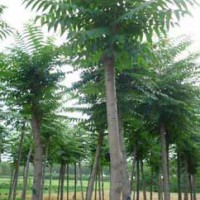Thousand heads
Alananthus altissima is a cultivated species of Ailanthus altissima, Ailanthus altissima and Ailanthus altissima. Deciduous tree, gray-brown bark, many branches, no obvious main trunk, the crown is funnel-shaped, egg-shaped or nearly spherical. The leaves are odd-pinnate compound leaves, alternate, with 13-25 small leaves, ovate-lanceolate to elliptic-lanceolate. Entire, light yellow flowers, terminal panicles. As the flowers fall off. Flowering period is from mid-May to early June. The samara is flat, brownish-yellow, slightly flushed before maturity, with no or few seeds.
Thousand-headed chrysanthemum therefore has extremely high ornamental value and a wide range of garden uses, and can be designed and configured in landscaping, landscape gardens and various garden green spaces. Thousand-head chrysanthemum can also be used as a good shade tree, ornamental tree or street tree. Thousands of wood can be used in construction, furniture, small farm tools, stationery equipment, sports equipment, etc.
Morphological characteristics:
Deciduous tree, about 30 meters high, with many branches, small angles, balanced growth, thick branches arranged in clusters, without obvious main trunk. The crown is funnel-shaped, egg-shaped or nearly spherical. The leaves are odd-numbered pinnate compound leaves, alternate, and even-numbered pinnate compound leaves. Some odd-numbered leaves are very small and linear, and the young leaves are slightly smelly. There are 13-25 leaflets, ovate-lanceolate to elliptic-lanceolate. Entire, the flowers are pale yellow, unisexual, without pistils, and the panicles are terminal. As the flowers fall off, the entire inflorescence gradually disappears. The general flowering period is about 20 days, and some are as long as more than a month, that is, from mid-May to early June, and the blooming period is mid-May. The samara is flat, brownish-yellow, slightly flushed before maturity, with no or few seeds.
Growth habits:
Rapid growth in spring, large growth, long internodes, slower growth in summer solstice and autumn, narrow internodes, full and dense axillary buds at the tip of the branches. In the second year, multiple twigs germinate from the tips of the branches, and the entire tree crown is formed one by one Big umbrella shape.
Reproduction method:
Generally it is breeding by sowing, cutting or grafting.
Main value:
Garden applications. The crown of the Thousand-Headed Chinensis is round as a hemisphere, which is quite spectacular. The leaves are large and the shade is thick, the red fruits are full in autumn, and it has many advantages such as tall tree body, beautiful tree posture, strong resistance, adaptability and fast growth. Therefore, it has extremely high ornamental value and extensive garden use. It can be used in landscaping, The design and configuration of landscape gardens and all kinds of courtyard green spaces, whether solitary planting, row planting, cluster planting or matching with other colorful tree species, can show its style and become the highlight of the landscape. Thousand-head chrysanthemum can also be used as a good shade tree, ornamental tree or street tree. Thousands of trees also have strong anti-smoke ability, so it is a good tree species for greening in industrial and mining areas. Because of its strong adaptability and strong sprouting ability, it is a pioneer tree species for mountain afforestation and an excellent tree species for water and soil conservation and soil improvement in saline-alkali land.
wood. The physical and mechanical properties of A. chinensis wood are medium, and the sum of the mass coefficient of forward pressure and static bending is greater than 2200, which is a high quality coefficient wood. Wood can be used in construction, furniture, small farm tools, stationery equipment, sports equipment, etc.










